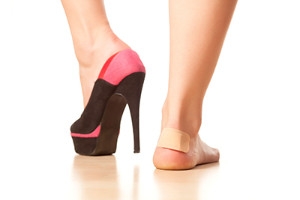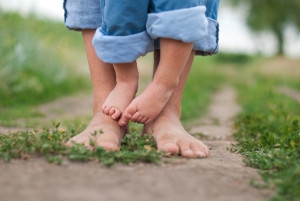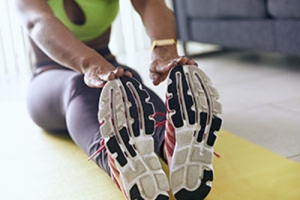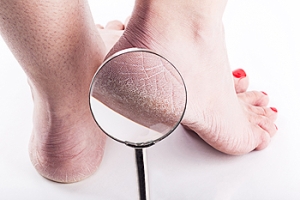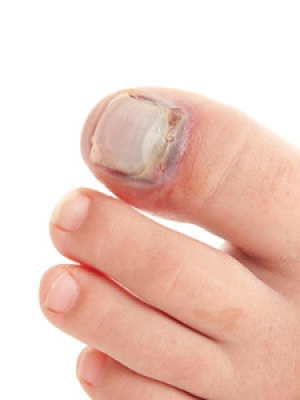
Rheumatoid Arthritis in the Feet
Rheumatoid Arthritis is a chronic progressive disease that attacks several joints throughout the body. It is an autoimmune disease in which the body’s immune system mistakenly attacks the joints. As a result, the tissue inside the joints, called synovium, starts to thicken and causes pain around the joints. The synovium is responsible for creating a fluid that lubricates the joints to help them move. Approximately 1.5 million people in the United States have Rheumatoid Arthritis. Women are almost three times as likely to have RA compared to men, and it’s disease usually begins between the ages of 30 and 60. People who have a genetic history of RA are more likely to develop the disease.
Symptoms of RA may include the following sensations in the joints: pain, tenderness, swelling, redness, warmth, stiffness, and loss of range. Swollen joints are a very common symptom for those with the disease. At times, it may be minimal, but it may also be very apparent. Another typical symptom is joint stiffness. Doctors will often use the direction of morning stiffness to measure the severity of a patient’s joint inflammation. Other RA symptoms include limping, anemia, fever, and fatigue.
To diagnose RA, your podiatrist will typically request x-rays to see how much damage there is in the joints. Blood tests may also be performed to show if there are any signs of anemia, or antibodies such as the rheumatoid factor. If you have previously been diagnosed with RA, you should know the disease may spread to your feet and ankles.
There are many non-surgical options that can be used to treat this ailment. Some of these options include physical therapy, foot massages, orthotics, bracing, supportive shoes, and steroid injections. Physical therapy is useful because it will help stretch and strengthen the joints in both the foot and ankle to improve joint function. Massages can help improve blood circulation which will be good for the feet. Choosing proper footwear will allow you to walk with comfortability if you are a sufferer from RA. Lastly, bracing will help stabilize the foot joints, limit deformities and decrease pain.
In severe cases, surgery may be a treatment option that should be considered. For those who cannot walk without experiencing pain and those whose deformities can not be managed with braces, surgery should be considered. Your podiatrist will recommend surgery if he or she believes it will improve your foot biomechanics.
Foot Conditions May Come from Wearing High Heels
 Research has indicated that foot pain women may experience may come from from wearing high heels. The balance in the body may be altered as a result of the ankles bending forward, and this is a feeling that is similar to standing on tiptoes. Additionally, the calf muscles may be shortened which may affect the Achilles tendon, and this may lead to painful injuries. It may be helpful to limit wearing high heels, or to choose a lower and wider heel. Stretching and resting the feet frequently throughout the day may be beneficial in preventing unwanted foot conditions that may be associated with wearing this type of shoe. If you would like additional information about the possible hazards associated with wearing high heels, it is suggested to consult with a podiatrist who can properly assist you.
Research has indicated that foot pain women may experience may come from from wearing high heels. The balance in the body may be altered as a result of the ankles bending forward, and this is a feeling that is similar to standing on tiptoes. Additionally, the calf muscles may be shortened which may affect the Achilles tendon, and this may lead to painful injuries. It may be helpful to limit wearing high heels, or to choose a lower and wider heel. Stretching and resting the feet frequently throughout the day may be beneficial in preventing unwanted foot conditions that may be associated with wearing this type of shoe. If you would like additional information about the possible hazards associated with wearing high heels, it is suggested to consult with a podiatrist who can properly assist you.
High heels have a history of causing foot and ankle problems. If you have any concerns about your feet or ankles, contact one of our podiatrists from New York Foot and Ankle. Our doctors can provide the care you need to keep you pain-free and on your feet.
Effects of High Heels on the Feet
High heels are popular shoes among women because of their many styles and societal appeal. Despite this, high heels can still cause many health problems if worn too frequently.
Which Parts of My Body Will Be Affected by High Heels?
- Ankle Joints
- Achilles Tendon – May shorten and stiffen with prolonged wear
- Balls of the Feet
- Knees – Heels cause the knees to bend constantly, creating stress on them
- Back – They decrease the spine’s ability to absorb shock, which may lead to back pain. The vertebrae of the lower back may compress.
What Kinds of Foot Problems Can Develop from Wearing High Heels?
- Corns
- Calluses
- Hammertoe
- Bunions
- Morton’s Neuroma
- Plantar Fasciitis
How Can I Still Wear High Heels and Maintain Foot Health?
If you want to wear high heeled shoes, make sure that you are not wearing them every day, as this will help prevent long term physical problems. Try wearing thicker heels as opposed to stilettos to distribute weight more evenly across the feet. Always make sure you are wearing the proper shoes for the right occasion, such as sneakers for exercising. If you walk to work, try carrying your heels with you and changing into them once you arrive at work. Adding inserts to your heels can help cushion your feet and absorb shock. Full foot inserts or metatarsal pads are available.
If you have any questions please feel free to contact one of our offices located in Franklin Square, Bethpage, Brooklyn, and Massapequa, NY . We offer the newest diagnostic and treatment technologies for all your foot and ankle needs.
Why High Heels Are Not Ideal for Healthy Feet
It is no secret that high heels are uncomfortable to wear for long periods of time. Although beauty is pain, you should not sacrifice the health of your feet for a stylish heel. Wearing high heels can potentially cause many different foot conditions that may be avoided by wearing proper footwear.
The structure of high heels forces weight of your body to get shifted forward toward the ball of the foot. The higher the heel you wear, the more weight and pressure get shifted forward. The pressure that your toes may experience from wearing heels may lead to hammer toes, bunions, and ingrown toenails. Extra weight and pressure resulting from wearing heels may cause stress fractures. Furthermore, heels may cause pinched nerves which may result in Morton’s neuroma.
High heels are even more dangerous for people who are clumsy. Falling or tripping while wearing heels can cause an ankle sprain or twist.
What many people don’t know is that heels can also cause back and knee problems. In order for your body to stay balanced on heels, your spine has to sway unnaturally, which adds stress to your spine muscles. This may cause you to experience a sore lower back.
If you decide to wear high heels regardless of the risks associated with them, there are ways you can minimize their harmful effects. One way to reduce injury is to massage and stretch your legs at the end of the day. Stretching can prevent the Achilles tendons and calf muscles from becoming too tight. If you are simply looking for more height, wedges and platforms provide a better surface area to distribute the body weight across compared to thinner heels.
If you experience pain from wearing high heels, it is important to see a podiatrist before any of your symptoms become worse.
How to Determine the Best Fitting Shoes for Your Child
 Research has shown the importance of children walking barefoot while indoors as often as possible. This may be helpful in developing the muscles of the feet and toes by allowing the foot to grasp the floor. When children walk outside, proper footwear needs to be worn, which may help to protect against injury. Before choosing a shoe, it is important to determine the correct shoe size. This can be accomplished by having both feet professionally measured and may be repeated as often as every two to three months. It may be helpful to have your child wear the socks that would normally be worn with the shoes, and this may ensure a proper fit. Additionally, it may be beneficial to choose a shoe that is made of materials, which offer adequate cushioning and support. If you would like additional information about how to choose shoes for your child, it is suggested to consult with a podiatrist.
Research has shown the importance of children walking barefoot while indoors as often as possible. This may be helpful in developing the muscles of the feet and toes by allowing the foot to grasp the floor. When children walk outside, proper footwear needs to be worn, which may help to protect against injury. Before choosing a shoe, it is important to determine the correct shoe size. This can be accomplished by having both feet professionally measured and may be repeated as often as every two to three months. It may be helpful to have your child wear the socks that would normally be worn with the shoes, and this may ensure a proper fit. Additionally, it may be beneficial to choose a shoe that is made of materials, which offer adequate cushioning and support. If you would like additional information about how to choose shoes for your child, it is suggested to consult with a podiatrist.
Making sure that your children maintain good foot health is very important as they grow. If you have any questions, contact one of our podiatrists of New York Foot and Ankle. Our doctors can provide the care you need to keep you pain-free and on your feet.
Keeping Children's Feet Healthy
Having healthy feet during childhood can help prevent medical problems later in life, namely in the back and legs. As children grow, their feet require different types of care. Here are some things to consider...
Although babies do not walk yet, it is still very important to take care of their feet.
Avoid putting tight shoes or socks on his or her feet.
Allow the baby to stretch and kick his or her feet to feel comfortable.
As a toddler, kids are now on the move and begin to develop differently. At this age, toddlers are getting a feel for walking, so don’t be alarmed if your toddler is unsteady or ‘walks funny’.
As your child gets older, it is important to teach them how to take care of their feet.
Show them proper hygiene to prevent infections such as fungus.
Be watchful for any pain or injury.
Have all injuries checked by a doctor as soon as possible.
Comfortable, protective shoes should always be worn, especially at play.
If you have any questions please feel free to contact one of our offices located in Franklin Square, Bethpage, Brooklyn, and Massapequa, NY . We offer the newest diagnostic and treatment technologies for all your foot and ankle needs.
What to Do to Keep Your Child’s Feet Healthy
Being a parent involves caring for your child in every way you can. You make sure they are eating the right food, being nice to others, and staying out of any trouble. However, it is also important that you are watchful of their health, more specifically their foot health. Maintaining good foot health in childhood is important in preventing later conditions in life from happening. As children continue to develop, their feet require different techniques of care. Here are some various ways in which you can help your child’s feet stay healthy.
A baby needs a lot of care and attention overall, but the importance of their feet should never be forgotten. Before a baby turns one, their feet change and develop greatly. It is important that during this time, a mother avoids putting tight socks on their child. She should also encourage movement of their feet so the baby can begin to feel more comfortable using them.
As a baby enters the toddler years of his or her life, they are begin to walk around. When your baby begins to take those first steps, it is crucial that they are wearing protective shoes on their feet. As a mother that is observant of your child’s feet, you may notice changes in them. This is completely normal as the feet are becoming susceptible to the activity of walking. It is normal for a toddler to be a bit unsteady or to “walk funny” at first.
When your child grows out of their toddler years, it is important that you begin to show him or her how to care for their feet on their own. Practice with your child proper hygiene in order to prevent foot fungus or infection. Since children are constantly on the move, it is crucial to be cautious of any accidents or injuries that might occur. If an injury occurs, it is advised that you take your child to be examined by a doctor immediately. Since your child is still growing, particular injuries can shift the way in which a bone or other important part of the foot is developing.
Babies and kids are always changing and growing. Your job as a parent is to make sure they stay healthy and making sure they are properly maintained. This involves proper foot care and making sure the feet stay healthy. Following this guide, your child can live a long and happy life.
Stretching Techniques That May Help to Prevent Running Injuries
 A fear that many joggers may have is to endure an injury that may prevent running. One way this can be soothed is by having a strong body, and this may be accomplished by performing strength training exercises. When the muscles and tendons are strong, the gait may be more consistent, and this may help to prevent tripping or falling. There are specific stretching techniques that can be performed which may decrease the risk of injury, which may include standing on one leg for as long as possible while lifting the heel. This may be beneficial in strengthening the calves, toes, and ankles. Additionally, if you stand on a step, drop one heel, then lift onto your toes, the Achilles tendon may become stronger. This may allow for a stable landing while running. If you would like additional information on how to prevent running injuries involving the foot, it is suggested to speak to a podiatrist.
A fear that many joggers may have is to endure an injury that may prevent running. One way this can be soothed is by having a strong body, and this may be accomplished by performing strength training exercises. When the muscles and tendons are strong, the gait may be more consistent, and this may help to prevent tripping or falling. There are specific stretching techniques that can be performed which may decrease the risk of injury, which may include standing on one leg for as long as possible while lifting the heel. This may be beneficial in strengthening the calves, toes, and ankles. Additionally, if you stand on a step, drop one heel, then lift onto your toes, the Achilles tendon may become stronger. This may allow for a stable landing while running. If you would like additional information on how to prevent running injuries involving the foot, it is suggested to speak to a podiatrist.
All runners should take extra precaution when trying to avoid injury. If you have any concerns about your feet, contact one of our podiatrists of New York Foot and Ankle. Our doctors will treat your foot and ankle needs.
How to Prevent Running Injuries
There are a lot of mistakes a runner can make prior to a workout that can induce injury. A lot of athletes tend to overstretch before running, instead of saving those workouts for a post-run routine. Deep lunges and hand-to-toe hamstring pulls should be performed after a workout instead of during a warmup. Another common mistake is jumping into an intense routine before your body is physically prepared for it. You should try to ease your way into long-distance running instead of forcing yourself to rush into it.
More Tips for Preventing Injury
- Incorporate Strength Training into Workouts - This will help improve the body’s overall athleticism
- Improve and Maintain Your Flexibility – Stretching everyday will help improve overall performance
- “Warm Up” Before Running and “Cool Down” Afterward – A warm up of 5-10 minutes helps get rid of lactic acid in the muscles and prevents delayed muscle soreness
- Cross-Training is Crucial
- Wear Proper Running Shoes
- Have a Formal Gait Analysis – Poor biomechanics can easily cause injury
If you have any questions, please feel free to contact one of our offices located in Franklin Square, Bethpage, Brooklyn, and Massapequa, NY . We offer the newest diagnostic and treatment technologies for all your foot care needs.
Preventing Running Injuries
Over half of all runners encounter at least one injury per year. The reason for this is because many runners do not train properly. Injuries are almost inevitable due to the physical stress that running causes. While our bodies are great at adapting to the stress, it can only handle it in small doses. Injuries occur when the stress is applied too quickly for the body to handle, causing something within it to break down. With each step you take, your leg is absorbing two or three times your body’s weight.
Some of the most popular running injuries are shin splints, plantar fasciitis, Achilles tendinitis, and stress fractures. Shin splints cause pain along the inside or outside of the shins, and this pain is usually felt at the beginning of a run. The condition itself is defined as an inflammation of the muscles or tendons located around the shinbone. To treat shin splints, it is advised that you ice the shin area and stretch the calf muscles. To prevent this injury, you should slowly increase the distance you plan on running, instead of jumping into a more strenuous routine.
Achilles tendinitis is another common injury and it feels like pain along the back of the leg, toward the heel. This condition is defined as an inflammation of the Achilles which is the largest tendon in the body. The Achilles is responsible for connecting your calf muscles to the heel bone and it is caused by tight calf muscles. If you want to treat this injury, you should take a break from running to cross train with a low-impact activity.
There are a lot of common mistakes runners make that are causing them to experience injury. One mistake is stretching too much prior to warming up. If you plan to go on a run, you should warm up with a gentle 3-5-minute walk followed by a 5-minute run-walk. Another common mistake is jumping into a routine too quickly. Consequently, you should incorporate cross-training into your routine. If you are looking to get active, you should slowly weave running into an activity you are currently participating in. For example, you can try bike riding for 40 minutes followed by a 10-minute run.
Another way to prevent running injuries is to choose shoes that are appropriate for running. There are certain things you should look for when buying a new pair of running shoes. An important factor in these sneakers is flexibility. Running shoes should be capable of bending and flexing at the forefoot. However, you should not be able to bend the entire shoe in half with ease because this is a sign that the shoe does not have enough structure. Additionally, you should look for the fit of the running shoes you want to purchase. It is best to visit a specialty running shoe store to have your feet properly sized. Choosing shoes that fit properly can prevent many foot ailments.
If you are suffering from any pain from running injuries, you should make an appointment with your podiatrist to discover the underlying cause of your pain. He or she will be able to help treat your condition in the best way possible.
Heel Balm for Cracked Heels
 Cracked heels are a common condition caused by dryness on the heel of the foot. Cracked heels can range from minor dryness that causes mild discomfort when barefoot, to deep cracks that cause pain. There are a couple ways to help alleviate symptoms of cracked heels from home. One of the simplest ways is to apply heel balm or a thick moisturizer. Balms help to moisturize, soften, and exfoliate dead skin. The ingredients that help to do this are urea, salicylic acid, alpha-hydroxy acids, and saccharide isomerate. Heel balms are easy to find, they can be bought at a drugstore or ordered online. Sometimes, heel balms might result in minor irritation. Minor irritation is normal, but if you experience continual irritation or more extreme reactions, then it is best to stop using the balm. If you have cracked heels and would like to learn about more ways to treat them, then it is strongly suggested you speak with a podiatrist.
Cracked heels are a common condition caused by dryness on the heel of the foot. Cracked heels can range from minor dryness that causes mild discomfort when barefoot, to deep cracks that cause pain. There are a couple ways to help alleviate symptoms of cracked heels from home. One of the simplest ways is to apply heel balm or a thick moisturizer. Balms help to moisturize, soften, and exfoliate dead skin. The ingredients that help to do this are urea, salicylic acid, alpha-hydroxy acids, and saccharide isomerate. Heel balms are easy to find, they can be bought at a drugstore or ordered online. Sometimes, heel balms might result in minor irritation. Minor irritation is normal, but if you experience continual irritation or more extreme reactions, then it is best to stop using the balm. If you have cracked heels and would like to learn about more ways to treat them, then it is strongly suggested you speak with a podiatrist.
If the skin on your feet starts to crack, you may want to see a podiatrist to find treatment. If you have any concerns, contact one of our podiatrists from New York Foot and Ankle. Our doctors can provide the care you need to keep you pain-free and on your feet.
Cracked Heels
It is important to moisturize your cracked heels in order to prevent pain, bleeding, and infection. The reason cracked heels form is because the skin on the foot is too dry to support the immense pressure placed on them. When the foot expands, the dry skin on the foot begins to split.
Ways to Help Heal Them
- Invest in a good foot cream
- Try Using Petroleum Jelly
- Ease up on Soaps
- Drink Plenty of Water
Ways to Prevent Cracked Heels
- Moisturize After Showering
- Skip a Shower
- Keep Shower Water Lukewarm
- Don’t Scrub Your Feet
If you are unsure how to proceed in treating cracked heels, seek guidance from a podiatrist. Your doctor will help you with any questions or information you may need.
If you have any questions, please feel free to contact one of our offices located in Franklin Square, Bethpage, Brooklyn, and Massapequa, NY . We offer the newest diagnostic and treatment technologies for all your foot care needs.
Solutions for Cracked Heels
Cracked heels can make life very frustrating and embarrassing when displaying the bare feet. Aside from being unpleasing to the eye, they can also tear stockings and socks and wear out shoes at a faster rate. When severe, cracked heels may cause pain or infection.
Cracked heels are a problem for those who are athletic, those who may walk a lot, and those who have especially dry skin. Those who use medication that dry the skin, those who swim often, wearing certain types of shoes, and those who are diabetic may have trouble with cracked heels. Seniors whose skin produces less oil may also have trouble with cracked feet. There is no one way to develop cracked feet, and there is no cure.
Today, the market consists of numerous products that have a variety of ingredients to promote healing. Some of these are over-the-counter. Others are prescribed by a doctor, especially for those who have chronic dry feet and heels.
Some doctors recommend wearing socks at night for those with rough skin. This helps further healing, and helps creams stay on longer and better absorb into the skin.
One way to alleviate dryness that causes cracked heels is by using moisturizers both day and night. Another way is to make sure the skin is clean and dry at all times. Using a pumice stone to buff away dead skin before putting on moisturizer can also help. Cracked heels will not respond to the cream unless the outer layer of skin is first removed through exfoliation. After exfoliation, lotion or ointment will be absorbed by the skin more easily.
Foods that produce healing and balance can also help the skin from within. Everything that is put into the body can either help it or hurt it. Taking supplements of omega-3 fatty acids and zinc can also be very beneficial.
Nevertheless, not all products are guaranteed to help treat cracked feet. Seeing a professional is best if other treatments options were unsuccessful. A podiatrist should be able to give the best advice to help with this problem.
Have I Broken My Toe?
 Broken toes are typically caused by an injury, or if a heavy object has been dropped on it. Some of the symptoms that may be associated with this condition may consist of severe pain and discomfort, bruising, or swelling. Many patients may find it difficult to walk if they have broken their toe, and this may be a result of an infection that may have developed. Additionally, walking may be hindered because the toe may feel stiff, and the nail bed may have been injured. After a proper diagnosis is performed, which typically involves having X-rays taken, the correct treatment can begin. Mild relief may be found by elevating the foot, in addition to putting minimum weight on it. It may be helpful to tape the injured toe to the toe next to it, and this may provide adequate stability as the healing process occurs. If you have broken your toe, it is suggested to speak to a podiatrist who can properly treat this condition.
Broken toes are typically caused by an injury, or if a heavy object has been dropped on it. Some of the symptoms that may be associated with this condition may consist of severe pain and discomfort, bruising, or swelling. Many patients may find it difficult to walk if they have broken their toe, and this may be a result of an infection that may have developed. Additionally, walking may be hindered because the toe may feel stiff, and the nail bed may have been injured. After a proper diagnosis is performed, which typically involves having X-rays taken, the correct treatment can begin. Mild relief may be found by elevating the foot, in addition to putting minimum weight on it. It may be helpful to tape the injured toe to the toe next to it, and this may provide adequate stability as the healing process occurs. If you have broken your toe, it is suggested to speak to a podiatrist who can properly treat this condition.
Broken toes may cause a lot of pain and should be treated as soon as possible. If you have any concerns about your feet, contact one of our podiatrists from New York Foot and Ankle. Our doctors will treat your foot and ankle needs.
What Is a Broken Toe?
A broken toe occurs when one or more of the toe bones of the foot are broken after an injury. Injuries such as stubbing your toe or dropping a heavy object on it may cause a toe fracture.
Symptoms of a Broken Toe
- Swelling
- Pain (with/without wearing shoes)
- Stiffness
- Nail Injury
Although the injured toe should be monitored daily, it is especially important to have a podiatrist look at your toe if you have severe symptoms. Some of these symptoms include worsening or new pain that is not relieved with medication, sores, redness, or open wounds near the toe.
If you have any questions, please feel free to contact one of our offices located in Franklin Square, Bethpage, Brooklyn, and Massapequa, NY . We offer the newest diagnostic and treatment technologies for all your foot care needs.
